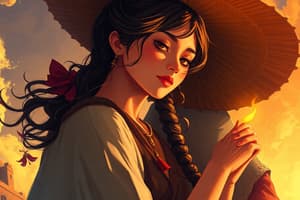Podcast
Questions and Answers
What is one characteristic that distinguishes literary works from ordinary writing?
What is one characteristic that distinguishes literary works from ordinary writing?
- Literary works always revolve around historical events.
- Literary works typically avoid emotional expression.
- Literary works deploy language in unique ways. (correct)
- Literary works are often less complex.
Which of the following best describes the scope of Philippine literature?
Which of the following best describes the scope of Philippine literature?
- Literature that focuses solely on religion.
- Literature associated with the Philippines from prehistory to the present. (correct)
- Literature only from the contemporary era.
- Literature only from the colonial period.
In the context of the provided Brain Teasers, which additional element is often a common feature in riddles?
In the context of the provided Brain Teasers, which additional element is often a common feature in riddles?
- A play on words. (correct)
- A moral lesson.
- A historical reference.
- An obvious answer.
How is literature viewed in its broadest sense?
How is literature viewed in its broadest sense?
Which of the following statements about the Brain Teaser answers is correct?
Which of the following statements about the Brain Teaser answers is correct?
Which of the following characteristics best describes the Pre-Colonial Period of Philippine literature?
Which of the following characteristics best describes the Pre-Colonial Period of Philippine literature?
During the Spanish Colonial Period, which literary form was NOT typically associated with religious literature?
During the Spanish Colonial Period, which literary form was NOT typically associated with religious literature?
What change occurred in Philippine literature during the Nationalistic/Propaganda and Revolutionary Period?
What change occurred in Philippine literature during the Nationalistic/Propaganda and Revolutionary Period?
Which of the following literary forms is associated with the Pre-Colonial Period?
Which of the following literary forms is associated with the Pre-Colonial Period?
Which of the following choices was a non-religious literary form during the Spanish Colonial Period?
Which of the following choices was a non-religious literary form during the Spanish Colonial Period?
What significant development replaced the oral tradition during the Spanish Colonial Period?
What significant development replaced the oral tradition during the Spanish Colonial Period?
Which literary form typically addressed the masses during the Nationalistic/Propaganda Period?
Which literary form typically addressed the masses during the Nationalistic/Propaganda Period?
What was the primary focus of literature during the Spanish Colonial Period?
What was the primary focus of literature during the Spanish Colonial Period?
Which literary work is considered a political novel from the Propaganda Literature period?
Which literary work is considered a political novel from the Propaganda Literature period?
What is a characteristic of the American Colonial Period from 1910 to 1945?
What is a characteristic of the American Colonial Period from 1910 to 1945?
Who authored the political poem 'Katapusang Hibik ng Pilipinas'?
Who authored the political poem 'Katapusang Hibik ng Pilipinas'?
Which literary work marks the transition into the Period of Emergence in the American Colonial Period?
Which literary work marks the transition into the Period of Emergence in the American Colonial Period?
What form of literature is associated with Emilio Jacinto during the Revolutionary Literature period?
What form of literature is associated with Emilio Jacinto during the Revolutionary Literature period?
During which period did Filipino writers imitate English and American models?
During which period did Filipino writers imitate English and American models?
Which form of drama is associated with the American Colonial Period?
Which form of drama is associated with the American Colonial Period?
What notable change occurred in Tagalog poetry during the War Years (1942-1944)?
What notable change occurred in Tagalog poetry during the War Years (1942-1944)?
Flashcards are hidden until you start studying
Study Notes
Pre-Colonial Period (up to 1564)
- Major literary characteristics included oral tradition focusing on daily life and activities, often using native languages.
- Prominent literary forms included bugtong (riddles), salawikain (proverbs), and folk tales.
- Poetry forms particularly notable were tanaga (quatrain), folk songs, and ethno-epics.
Spanish Colonial Period (1565-1863)
- Literature featured religious themes and non-religious topics, transitioning from oral tradition due to the invention of the printing press.
- Spanish became the primary language of literature, leading to various literary forms.
- Religious works included Doctrina Christiana and poetry such as Mahal na Passion ni Jesu Christo.
- Dramatic forms featured during this period were Senakulo and Komedya (Moro-Moro).
- Non-religious poetry included awit (e.g., Florante at Laura) and korido (e.g., Ibong Adarna).
- Prose narratives included dialogo, ejemplo, Manual de Urbanidad, and tratado.
Nationalistic/Propaganda and Revolutionary Period (1864-1896)
- Literature focused on opposing Spanish oppression with a shift from Spanish to Tagalog, aiming to reach the masses.
- Key propaganda literary forms included political essays such as Diariong Tagalog.
- Notable political novels were Noli Me Tangere and El Filibusterismo by José Rizal.
- Revolutionary literature included political essays like Kalayaan (Emilio Jacinto) and political poems such as True Decalogue (Apolinario Mabini) and Katapusang Hibik ng Pilipinas (Andres Bonifacio).
American Colonial Period (1910-1945)
- Experienced a period of apprenticeship (1910-1930) where Filipino writers imitated English and American literary styles, producing amateurish poetry.
- A period of emergence (1920-1930) showcased rising influences from Western literary trends such as Romanticism and Realism.
- Notable short stories included Dead Stars (Paz Marquez Benitez), The Key (Paz Latorena), and Footnote to Youth (Jose Garcia Villa).
- Novels such as A Child of Sorrow (Zoilo Galang) gained prominence.
- Dramatic forms included zarzuela (musical plays).
Japanese Occupation Period (1942-1944)
- During the war years, Tagalog poets began to diverge from the more formal Balagtas tradition, opting for simple language and free verse styles.
Studying That Suits You
Use AI to generate personalized quizzes and flashcards to suit your learning preferences.




